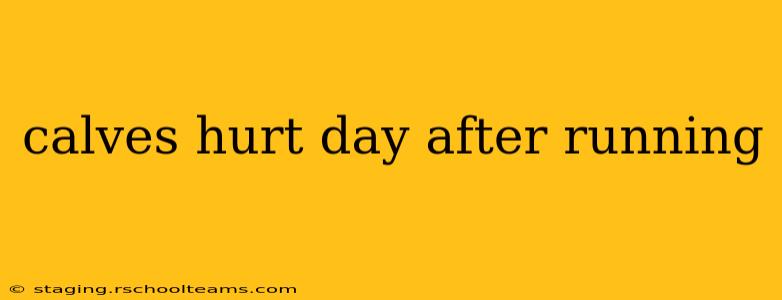Running is a fantastic way to improve cardiovascular health and overall fitness, but it can sometimes leave your calves aching the day after a workout. This post will explore the common reasons why your calves might be sore after running, offer preventative measures, and suggest effective treatments to alleviate the pain and get you back on the road (or trail!) quickly.
Why Do My Calves Hurt After Running?
Muscle soreness after running, often referred to as Delayed Onset Muscle Soreness (DOMS), is a common experience, especially after intense or unusual workouts. Several factors contribute to this post-run calf pain:
-
Overexertion: Running, particularly uphill or at a faster pace than usual, puts significant stress on your calf muscles (gastrocnemius and soleus). Overworking these muscles without adequate preparation leads to micro-tears in the muscle fibers, resulting in inflammation and pain.
-
Improper Form: Incorrect running form, such as overstriding or landing heel-first, can place excessive strain on your calves. This uneven stress distribution can trigger muscle soreness and potential injuries.
-
Inadequate Warm-up: Neglecting a proper warm-up before running leaves your muscles unprepared for the demands of the workout. Cold muscles are more prone to injury and subsequent soreness.
-
Insufficient Cool-down: A cool-down helps your body gradually transition from high-intensity exercise to rest. Skipping this crucial step can exacerbate muscle soreness.
-
Dehydration: Dehydration can impede muscle recovery and increase the risk of muscle cramps and soreness.
-
New Running Shoes: Switching to a new pair of running shoes can also cause calf soreness. The different cushioning and support offered by different shoe models can impact your running style and muscle usage.
How Can I Prevent Calf Soreness After Running?
Preventing calf pain involves a holistic approach encompassing training, warm-up, cool-down, and hydration. Here are some key preventative measures:
-
Gradual Progression: Avoid increasing your running mileage or intensity too rapidly. Gradually increase your running volume and intensity over time to allow your muscles to adapt.
-
Proper Warm-up: A dynamic warm-up, involving movements like leg swings, high knees, and butt kicks, prepares your muscles for the workout.
-
Strengthening Exercises: Incorporate calf strengthening exercises into your routine, such as calf raises, to build muscle strength and endurance.
-
Stretching: Regular stretching, both before and after running, improves muscle flexibility and reduces the risk of injury. Focus on stretches that target the gastrocnemius and soleus muscles.
-
Proper Running Form: Maintain a proper running form, focusing on midfoot or forefoot strikes to minimize impact on your calves. Consider seeking guidance from a running coach to correct any form issues.
-
Hydration: Stay adequately hydrated before, during, and after your run.
What Can I Do If My Calves Are Already Sore?
If you're already experiencing calf soreness, several strategies can help alleviate the pain and promote recovery:
-
Rest: Allow your muscles time to recover. Rest is crucial for muscle repair. Avoid strenuous activity that further stresses your calves.
-
Ice: Apply ice packs to your sore calves for 15-20 minutes at a time, several times a day. This helps reduce inflammation.
-
Elevation: Elevate your legs when resting to improve blood circulation and reduce swelling.
-
Compression: Wearing compression socks can improve blood flow and reduce muscle swelling.
-
Over-the-counter pain relievers: Nonsteroidal anti-inflammatory drugs (NSAIDs) like ibuprofen can help reduce pain and inflammation. Always follow the recommended dosage.
-
Massage: Gentle massage can help improve blood flow and reduce muscle tension. Self-massage or professional massage therapy can be beneficial.
-
Foam Rolling: Using a foam roller on your calves can help release muscle tightness and improve flexibility.
How Long Will My Calf Soreness Last?
The duration of calf soreness varies depending on the severity of the discomfort and individual factors. Typically, DOMS peaks within 24-72 hours after exercise and gradually subsides within 3-7 days. If the pain persists for longer than a week or is accompanied by other symptoms like swelling, redness, or limited range of motion, consult a doctor or physical therapist.
What if the Pain is Severe or Doesn't Improve?
Severe or persistent calf pain that doesn't improve with rest and home remedies may indicate a more serious injury, such as a muscle strain, tear, or other underlying condition. If you experience any of the following symptoms, consult a medical professional:
- Severe pain
- Swelling
- Bruising
- Limited range of motion
- Numbness or tingling
Remember, listening to your body is crucial. Don't push through extreme pain. Prioritize proper rest, recovery, and seeking professional advice when needed. By following these preventative measures and treatment strategies, you can minimize calf soreness and continue enjoying your runs without discomfort.
